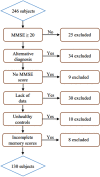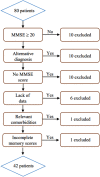Memory Outcome in Prodromal and Mild Dementia with Lewy Bodies and Alzheimer's Disease: A Longitudinal Study
- PMID: 37212104
- PMCID: PMC10357191
- DOI: 10.3233/JAD-221243
Memory Outcome in Prodromal and Mild Dementia with Lewy Bodies and Alzheimer's Disease: A Longitudinal Study
Abstract
Background: Dementia with Lewy bodies (DLB) and Alzheimer's disease (AD) are likely to induce memory impairments from the prodromal stage but, to our knowledge, no longitudinal study of these patients' memory profile has been conducted to date.
Objective: The aim of our study was to describe the characteristics and the evolution of the long-term memory profile of patients with prodromal and mild DLB and AD.
Methods: We collected verbal (RL/RI-16) and visual (DMS48) memory scores from 91 DLB patients, 28 AD patients, 15 patients with both conditions (DLB/AD), and 18 healthy control subjects at their inclusion visit and at 12, 24, and 48 months.
Results: On the RL/RI-16, DLB patients performed better than AD patients in terms of total recall (p < 0.001), delayed total recall (p < 0.001), recognition (p = 0.031), and loss of information over time (p = 0.023). On the DMS48, differences between these two groups were not significant (p > 0.05). Longitudinally, the memory performance of DLB patients was stable over 48 months, unlike that of AD patients.
Conclusion: Four indicators were relevant to distinguish between DLB and AD patients in terms of memory performance: DLB patients benefitted greatly from semantic cueing, their recognition and consolidation abilities were well-preserved, and both their verbal and visual memory performance remained remarkably stable over four years. However, no performance differences between DLB and AD patients were found regarding visual memory, either qualitatively (memory profile) or quantitatively (severity of impairment), indicating the lesser relevance of this test in distinguishing between these two diseases.
Keywords: Alzheimer’s disease; DMS48; Lewy body disease; RL/RI-16; dementia with Lewy bodies; diagnosis; memory; mild cognitive impairment.
Conflict of interest statement
The authors have no conflict of interest to report.
Figures





References
-
- McKeith IG, Boeve BF, Dickson DW, Halliday G, Taylor JP, Weintraub D, Aarsland D, Galvin J, Attems A, Ballard CG, Bayston A, Beach TG, Blanc F, Bohnen N, Bonanni L, Bras J, Brundin P, Burn D, Chen-Plotkin A, Duda JE, El-Agnaf O, Feldman H, Ferman TJ, Ffytche D, Fujishiro H, Galasko D, Goldman JG, Gomperts SN, Graff-Radford NR, Honig LS, Iranzo A, Kantarci K, Kaufer D, Kukull W, Lee VMY, Leverenz JB, Lewis S., Lippa C, Lunde A, Masellis M, Masliah E, McLean P, Mollenhauer B, Montine TJ, Moreno E, Mori E, Murray M, O’Brien JT, Orimo S, Postuma RB, Ramaswamy S, Ross OA, Salmon DP, Singleton A, Taylor A, Thomas A, Tiraboschi P, Toledo JB, Trojanowski JQ, Tsuang D, Walker Z, Yamada M, Kosaka K (2017) Diagnosis and management of dementia with Lewy bodies: Fourth consensus report of the DLB Consortium. Neurology 89, 88–100. - PMC - PubMed
-
- McKeith IG, Ferman TJ, Thomas AJ, Blanc F, Boeve BF, Fujishiro H, Kantarci K, Muscio C, O’Brien JT, Postuma RB, Aarsland D, Ballard C, Bonanni L, Donaghy P, Emre M., Galvin JE, Galasko D, Goldman JG, Gomperts SN, Honig LS, Ikeda M, Leverenz JB, Lewis SJG, Marder KS, Masellis M, David P, Salmon DP, Taylor JP, Tsuang DW, Walker Z, Tiraboschi P; prodromal DLB Diagnostic Study Group (2020) Research criteria for the diagnosis of prodromal dementia with Lewy bodies. Neurology 94, 743–755. - PMC - PubMed
-
- Cagnin A, Bussè C, Jelcic N, Gnoato F, Mitolo M, Caf-farra P (2015) High specificity of MMSE pentagon scoring for diagnosis of prodromal dementia with Lewy bodies. Parkinsonism Relat Dis 21, 303–305. - PubMed
Publication types
MeSH terms
LinkOut - more resources
Full Text Sources
Medical

